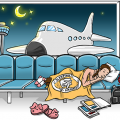Let me get this out of the way: I’m one of those “crazy” carry-on only travelers. I prefer to keep my things with me at all times. I hate the fear of losing a bag, having things stolen, or having a bag damaged. I also hate having to wait at baggage claim for my bag. I’d rather get out of the airport as quickly as possible. But sometimes carry-on only isn’t an option, or your bag gets gate checked. So here are my best tips if you have to part from your bag.
Main Carry-On
One way I’ve made the change to carry-on only is by packing efficiently and carry as few liquids on me as possible. I’ve moved on to mostly solid sunscreen, solid shampoo, solid condition, solid toothpaste, bug spray wipes, anti-bacterial wipes, etc. This means most of my liquids are now contact solution, eye drops, one backup liquid sunscreen, and any makeup chapstick/lipstick, mascara, etc. And then by planning to wash my clothes and packing mix-and-match outfits, I can pack fewer items.
I also have invested in proper carry-on sized bags, although smaller airplanes may not be able to accommodate “normal” sized carry-ons, so that is always a change I might have to gate check. Another issue I seem to have is where one part of my bag might be just an itsy bitsy too big to shove into the overhead bin. I usually pack a jacket or larger fabric item towards the top of the bag, so I can quickly zip it open and pull it out so the bag can fit better if needed.
Lastly, if you are unsure, you can check the TSA website to find out what items are banned from carry-on and checked luggage. Knowledge ahead of time will avoid any surprises.
Backup Carry-On
Firstly, even if you are checking a bag, you should have a small carry-on bag with you. You’ll want anything important that you cannot loose such as IDs, car/house keys, credit/debit cards, medications, etc. You’ll also want to carry-on expensive items like jewelry and electronics (or leave them at home). And carry-on any fragile or breakable items as the bags are not “handled with care” when being loaded/unloaded onto the plane.
In addition, it’s helpful to pack in your carry-on anything you’ll need right after landing in case your main bag is lost or delayed. For example, if you are on a beach vacation, pack your swimsuit. It is also good to have 1-2 worth of clothes in this backup carry-on, so that way your vacation isn’t derailed due to a lost/delayed bag.
Even if I’m not checking a bag, I’ll place the above items in a smaller collapsible bag within my carry-on bag. So if I do have to gate check my bigger carry-on, I can quickly grab the essentials and be fine.
Checked Bags Tips
I frequent travel message boards, and there are a lot of first-time travelers who are so worried about checking their bags. Here are my recommendations to help ensure their bags don’t get lost. Some are pretty “duh” while others are a little more extreme. Use whatever ones you personally prefer!
Getting Your Bag To Its Destination
Always remove past flight ticket/baggage information from your bag. Why play roulette to see if they scan the right tag? (Plus, I’ve found you can use the sticky side of the tag as an emergency lint roller if you need to spruce up your nicer outfits.)
If you are really worried about your bag getting lost in transit, you can also go the extreme measure by putting a piece of ducktape on each side of the bag and with a sharpie write the intended destination on the bag (like “Destination: Costa Rica”). It looks stupid, but it’s a surefire way for the bag not to get lost. It’s unusual and baggage handlers might be like “Well damn, this bag ISN’T in Costa Rica, but it needs to get there!”
Also, it’s a good idea to have a printed copy of your itinerary in an easily accessible pocket in your bag. That way if TSA or the airline loose the bag, and open it up to try to figure out who it belongs to, they can easily see where the bag was supposed to go. If you also know the address(s) of your first few nights include that as well. It will make it easier if your bag is temporary lost/delayed and the airline is delivering your bag to you.
A Name To A Bag (Both Inside And Out)
Always make sure to have proper name tags with updated addresses and phone numbers on your bags (as well as your carry-on bags in case they are gate checked, or you simply accidentally left them on the plane!) Sure, the free paper ones are convenient, but they can break off easily.
Again, placing a print out of your contact information, your itinerary, and where you’ll be will help in case the bag is lost or delayed.
Make It Unique & Sturdy
You’ll want to make your bag unique to keep it from accidentally being claimed by someone else (or walked off with). If you don’t have a unique fabric or colored bag, you can simply add ribbon or fabric to the handles to make it unique. Other ideas to customize your bag is adding stickers, patches, or even paint it.
I also recommend a colorful bag band. This helps you find your bag faster, as well as helps keep the bag closed in case of damage to the bag. (Nothing is worse than seeing your items come up the carousel all loose.) On that note, you also will want to repair or replace damaged or old luggage if seams or zippers start to break. (A quick fix if you are on the road is to use dental floss and a needle to sew it back up, and then use duck tape to further reinforce it.) Also, don’t overpack your bags. If you have trouble shutting it, imagine TSA trying to re-shut it after they search it, or heaven forbid one jolt, drop, or bump and your bag just expels its contents.
If your bag has a lot of straps (especially ones that you cannot stow away), you may need to see if the airport offers bag wrapping or has a separate area where they load backpacks and other awkward items. Also, take off any hanging attachments that can be removed, otherwise they will do it for you (and likely throw away the attachments.) I’ve lost duffle bag shoulder straps and carabiners that way.
Finally, you’ll want to make your bag tamper proof. Only utilize TSA approved locks (otherwise they’ll just cut them off), or for a cheaper solution use twist ties to twist the bag shut. It will deter quick thieves, but TSA will still be able to get into the bag. Note that it is actually very easy to break a zipper with just a ballpoint pen, so utilizing airport bag wrapping service is another way to ensure the bag hasn’t been opened.
Keep Records
Take photos and notes of your bag and contents that you packed for two reasons:
Firstly, if your bag is lost you can provide the photo of the outside of the bag (hopefully with unique characteristics as outlined above) so that way airport and airline staff can find it faster.
Secondly, if the bag is permanently lost you’ll want notes and photos so you can prove what items were in the bag. Many airlines will also require you show receipts of the items in your bag, so they know how much to reimburse you. You’ll also want to keep receipts for any items you purchased while waiting for your luggage if the luggage is delayed. But keep in mind, the airlines has limits on what they consider “necessities”, so don’t think you can buy a whole new wardrobe and expect the airline (or your travel insurance) to foot the bill. And while I always recommend travel insurance, you may have travel insurance protections on the credit card you used to purchase the flight and/or your homeowners insurance may cover lost/stolen items.
Also, make sure to keep baggage claim tickets in a secure place, you’ll need them if the bag is lost. I also make sure to double check the tag on my bag to see if it has the proper airport code and is going to the proper place. Sometimes the check-in agent may make a mistake and tag your bag to one of your layover destinations and not to your final destination.
Other Notes
Check in early (but not too early)! If you leave it too late your bag might not get on the plane due to timing or other mishaps. It is also a good idea to avoid very short layovers (or if you can choose direct flights). But you also don’t want to check in hours early, because the baggage handlers will be working other flights, so your bag may be set aside. Also get to the baggage claim quickly to ensure no one walks off with your bag.
If you are traveling with multiple people, consider cross-packing. That is where each bag contains some items for every person. So if one person’s bag goes missing, they still have some clothes to wear in their companion’s bag.
There is a growing market for RFID or “GPS” style bag finders/trackers. I’ve not personally used them but here are the common critics I see on these:
- Some only work when the bag is nearby the owner’s phone and if the bag is near an open wifi connection. This means it’s not helpful if the bag is truly lost.
- Some “smart tags” require that the airport uses a specials proprietary scanning device to scan the smart tags. I know of no company who has that type of market penetration to make this at all helpful right now.
- Some are expensive or require a paid service to work. If you don’t travel that often then it might not be worthwhile.
But I’m eager to see what this industry will come up with in the future.







Leave a Reply